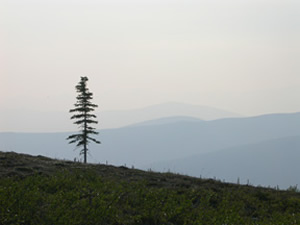Tree line changes on the Kenai Peninsula
Tree line changes on the Kenai Peninsula
Submitted by Ned Rozell
Phone: 907-474-7468
02/07/08

The late Yule Kilcher, a Swiss homesteader who knew the landscape around Homer better than anyone, once told ecologist Ed Berg that during Kilcher’s half century of observing the natural world around him, trees in the area had crept "at least several hundred feet" up the hills.
Two students at Alaska Pacific University recently confirmed at least part of Kilcher’s observation. They looked for changes in the tree line of the western Kenai Peninsula and found it has risen about a yard each year since 1951 on north-facing slopes. Tree line didn’t change much on south-facing slopes, but trees and bushes got denser there.
Katrina Timm and Alissa McMahon compared photos of the western Kenai hills from the 1950s to photos of the same area taken in 1996 to see the changes in tree line, which is among the most gradual and spotty indicators of warming. In comparing the photos and hiking into the hills to sample trees and take detailed measurements, the pair also found that 20 percent of the alpine tundra that existed in 1951 had become shrubbery or open woodlands by 1996. They wrote up their results in the Journal of Geological Research.
The gradual change in tree line is one of many that people have noticed on the Kenai Peninsula in recent years. The most obvious is the 1980s-to-1990s Spruce bark beetle invasion, during which the insects killed 30 million mature spruce trees on the Kenai and a wide swath of southern Alaska. Harding Icefield, coating the high country of the peninsula with tendrils of glacier reaching toward the sea, also has shrunk more than 70 feet in elevation during the last half century, and kettle ponds on the peninsula are drying up.
Ed Berg, an ecologist with the Kenai National Wildlife Refuge for the past 15 years, has noticed other subtle changes in the trees of the Kenai. Since Yule Kilcher alerted him to what he perceived to be a fast-moving tree line, Berg kept his eye on the trees growing at the edge of alpine areas. He noticed that gnarled dwarf evergreens up high were becoming a rarity. These trees, called "krummholz" ("twisted wood" in German) by foresters, have lush growth near the ground where snow protects them from wind-driven ice crystals. They are quite small for their age; Kenai krummholz hemlock six inches in diameter have been alive since the 1500s, Berg wrote in a 2004 article for the Kenai National Wildlife Refuge. In the article, he wrote of the major change he noticed in the forest of "twisted gnomes," possibly due to less extreme weather.
"Kenai mountain hemlocks aren’t doing krummholz anymore," Berg wrote. "Baby hemlocks now grow straight up at tree line, and have probably been doing so for much of the 20th century, to judge from the upright saplings growing amidst the krummholz ancients."
The changes in Kenai Peninsula trees might be due to the milder weather the peninsula, along with most of Alaska, has experienced since about 1977, when ocean-surface temperatures in the North Pacific warmed. Climatologists with the Alaska Climate Research Center report that the Homer area warmed 4.2 degrees Fahrenheit on average from 1949 to 2007.
As for the near future, people can expect to see more changes in the area, according to Roman Dial, a professor at Alaska Pacific University and the advisor to Timm and McMahon.
"Even if the climate were to reverse itself today, the changes we have already seen during the last 50 to 100 years would likely take more than that length of time to reverse themselves," Dial wrote in an article for the newspaper, Peninsula Clarion.
This column is provided as a public service by the Geophysical Institute, University of Alaska Fairbanks, in cooperation with the UAF research community. Ned Rozell is a science writer at the institute. To view past columns or to subscribe, visit www.gi.alaska.edu/ScienceForum/index.html.


